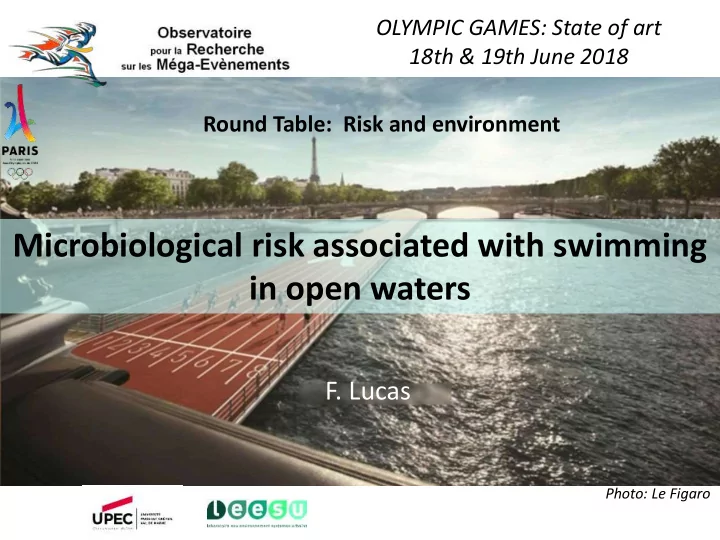

OLYMPIC GAMES: State of art 18th & 19th June 2018 Round Table: Risk and environment Microbiological risk associated with swimming in open waters F. Lucas Photo: Le Figaro
Triathlon de Paris 2010 (https://www.nageurs.com) Open waters: lakes, rivers, reservoirs, ocean Triathlon Marathon swimming
2024 Olympics: Alfortville Seine River
Triathlon de Paris 2010 (https://www.nageurs.com) Open waters: lakes, rivers, reservoirs, ocean Highly diverse microbial communities => Could contain: - Waterborne pathogens of fecal origin - Opportunistic pathogens indogenous of aquatic ecosystems
Sanitary risks: Infections Respiratory infection: Adenovirus, Aeromonas, Mycobacteria … Respiratory Ear infection: Pseudomonas Ear aeruginosa ,… Skin Skin infection: Staphylococcus aureus , … Gastroenteritis: enteric viruses, Giardia, Cryptosporidium, Gastroenteritis Campylobacter, Salmonella, Shigella, Vibrio cholerae, Escherichia coli H7:O157.... Toxine : cyanobacteria, Dynophyceae
Routes of infection: Ingestion: Submersion of the face Water spray on the face 75% of triathletes swallow water 10-34 ml swallowed/event (Medema et al. 1997, Dufour et al. 2006, Schets et al. 2011) Inhalation: Water spray on the face cuts, grazes, orifices, mucous membranes: Whole body immersion Lower immunological defences Intense & prolonged physical activity mental stress (Friman and Wesslen 2000)
Outbreaks associated with swimming in surface water Netherlands (1991 – 2007) =>742 outbreaks (Schets 2011) 5623 patients USA (1991-2006) => 138 outbreaks Cryptosporidium 36-89% gastroenteritis Giardia 5-38% neurological conditions ( Naegleria fowleri ) norovirus 5-21% skin conditions (schistosomes) United Kingdom (1992-2003) => 5 outbreaks
Infective dose : 50% of the exposed population exhibit symptoms + exposure : quantity swallowed => Calculation of the risk of infection Giardia lamblia: ID 50 = 34,8 Not available for all the pathogens Cryptosporidium parvum: ID 50 = 173,1 Rotavirus: ID 50 =6,11 Campylobacter jejuni : ID 50 = 890
Risk for triathletes to contract gastroenteritis Van Asperen et al. (1998) Epidemiological studies (Pruessen, 1996; Wiedmann et al. 2006) => threshold values for water regulations => Fecal indicator bacteria ( Escherichia coli , intestinal enterococci)
Risk at the potential olympic site: Monitoring in summers 2016 & 2017 90 th Percentiles Alma : 3518 E. coli /100 mL 900 E. coli Iena : 8187 E. coli /100 mL /100 mL Water quality in the Seine River => insufficient for bathing according to the EU legislation
Risk at the potential olympic venue: Fecal indicator bacteria at the Olympic venue: 90th Percentiles > 900 E. coli /100 mL >10% of risk to contract a gastroenteritis >3,8% of risk to contract a respiratory infection (WHO 2013) Pathogens upstream the Olympic venue: Rotavirus ~1000 genome unit/L ~34 ingested> ID 50 = 6 Giardia sp. Cryptosoridium sp. 60 cysts/10L 5 oocysts/10L <ID 50 =35 < Infective dose
Risk at the potential olympic site: High Mitigation strategies concentrations of to improve the quality Fecal indicators => Coordinated actions of 34-44% of the stakeholders and local samples authorities in Ile de < 900 E.coli/100mL France => Which level of mitigation is enough ? - modeling - monitoring
Risk at the potential olympic site: Temporal variation is it predictible? - Rainfalls - Accidental pollutions
Impact of rain event on the water quality Triathlon in Copenhagen harbour 1.5x10 4 E. coli/ 100 ml 2010: after a 20 year rain event=> 2011: <500 E. coli /100mL Number of cases of illness Attack rate: 2010 : 42% (n=838) 2011: 8% (n=931) Campylobacter, Giardia lamblia and diarrhoeagenic E. coli. (Harder-Lauridsen et al. 2013)
Risk at the potential olympic site: Rainfalls St Maurice (Marne River) 120 h cumulated pluviometry (mm) How to manage? EU directive =>No swimming for 3 days after a rain event
Alert system => fine tuning the management of accidental pollution and rainfall? In situ monitoring of the pollution upstream the Olympic venue?: - Alert (Fluidion) - ColiMinder (VWM)
Conclusions : today not suitable for swimming according to the EU regulation > 10 % of risk to declare gastroenteritis due to enteric viruses Strategies to lower the risk: - Improvement of the water quality - Management of storm events - Advices for athletes vaccinations, avoid swallowing water, shower after the competition Clean swimming suits and equipment after the competition
Mass gathering => risk for transmission of infectious diseasis Infectious diseasis reported to the daily Health Protection Agency during London 2012 Olympics/paralympics (McCloskey et al. 2014) Atlanta 1996, Sydney 2000, Beijing 2008: <1% of health care visits were for infectious diseasis Athens 2004 6-7% respiratory infections 3-7% gastroenteritis Salmonellosis, tuberculosis, hepatitis B, meningitis
THANKS FOR YOUR ATTENTION Triathlon de Paris 2010 (https://www.nageurs.com) thanks to : JM Mouchel, L. Moulin, P. Servais, S. Wurtzer, B. de Gouvello all the members (stakeholders, local authorities) of the Working Group “ Qualité de l’eau et baignade ”
Recommend
More recommend